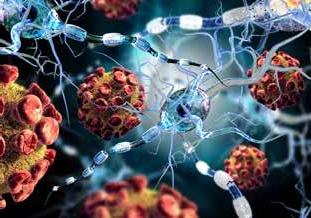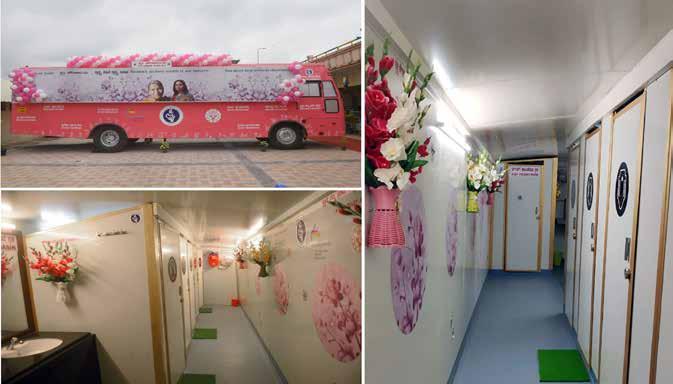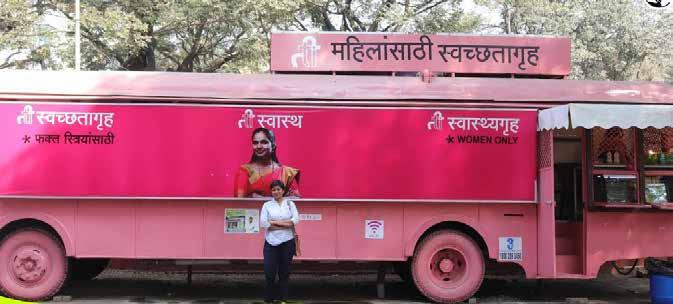
15 minute read
Newscan
Indian ULBs lead the way to organic pollutant filtration Best ULB in East Zone under Best City in ‘Innovation and Practices’ was awarded to Birgaon, Chhattisgarh (more than 50,000 to 1 lakh) and Jugsalai, Jharkhand was awarded in cities with more than 25,000 to 50,000 population. Birgaon used ‘Mushroom Compost Absorption’ method for treating heavy metals. Mushroom Mycelia is used as a membrane for filtration of pollutants such as heavy metals using microorganisms present in mushroom and slit. Jugsalai Nagar Parishad came up with the idea of using tea leaves for processing it into highly nutritious compost. This initiative is managed at the ULB level with the help of a Self-Help Group (SHG) named Prerna Mahilla Samiti. Tea leaves are a rich source of nitrogen compound for plants and soil in the form of compost. These tea leaves are collected from approximately 50 tea stalls around Jugsalai. This has also resulted in the reduction of wet waste.
Petland working to achieve responsible waste segregation, recycling
Advertisement
In West Zone, the award for Best City in ‘Innovation and Practices’ was given to Petland ULB of Gujarat(more than 50,000 to 1 lakh). Petland Municipality Area has deployed Yellow E-Rickshaw for on-call collection of bio-hazardous wastes such as sanitary pads, diapers, personal protective equipment, gloves, masks etc. They have also set up a fertilizer plant for recycling the wet waste collected from households and businesses across the city. The manure is then used for revenue generation by selling it in the markets as well as in municipal gardens and plantations. Thus, the innovation not only works well as an environmentally friendly practice but also helps the municipality in generating extra revenue to use in other developmental activities.
Adopting smart solutions for better SWM at grassroot level
Vita Municipal Council (VMC) won the award for the Best City in ‘Innovation and Practices’ in the West Zone in the ‘more than 25,000 to 50,000 population category. VMC has installed twin bins in the prominent areas. These bins can compress the waste collected to 1/5th of its original size with the help of a preinstalled mechanised motor. This motor is powered by the way of solar sheet installed at its top cover. It automatically sends a Wi-Fi signal to authorities when it gets filled. It serves the purpose of saving time and power, waste reduction and also offers a space for advertisement. This is not only a technologically smart initiative but also makes the people more responsible towards their duty of keeping their city clean. released by theMoHUA, almost 59,900 toilets across more than 2900 cities have been made live on Google Maps.
Civic authorities have also worked very hard for the tremendous success of SWM-U. Nearly 97 per cent of the wards in India have door to door collection of waste, 77 per cent have source segregation with almost 67 per cent of the waste being processed. Data shows that waste processing has witnessed an almost four-fold jump since 2014 (18 per cent). As per MoHUA’ Star Rating Protocol for Garbage Free Cities, six cities (Indore, Ambikapur, Navi Mumbai, Surat, Rajkot and Mysuru) have been awarded 5-star rating. Besides this, almost 86 cities are 3-star and 64 cities are 1-star rated by the Ministry. The last edition of Swachh Survekshan 2020 conducted by MoHUA witnessed the participation of 12 crore citizens. This means that the Mission has evidently transformed this government program into a mass movement.
A true “Jan Andolan”, according to MoHUA, the mission has emphasised on providing decent living places to all sanitation workers and informal waste collectors. The mission has brought around 84,000 waste pickers in the mainstream, in line with Mahatma Gandhi’s vision of equality and inclusion for all sections of society. Over 5.5 lakh sanitation workers have been successfully inducted into various welfare schemes of the central government.
Capacity building of the ULB officials has been a vital part of the program. In this regard, the Ministry has successfully conducted around 150 workshops across India with almost 6,000 people participating from 3,200 ULBs. These workshops were organised with the help of NIUA. SBM aimed to achieve the vision of Narendra Modi, Prime Minister, Government of India, of having a “Clean India” by October 2, 2019. The urban wing of the mission was implemented by MoHUA to make urban India ODF with modern and scientific waste management techniques.
BRIEFS | NEWSCAN
Kerala gets its first dedicated COVID-19 facility
Pinarayi Vijayan, Chief Minister of Kerala, inaugurated the first dedicated COVID-19 hospital of the state built by the Tata Group. He said that it is the perfect example of how a Public-Private Partnership (PPP) can be put to good use.The facility was built in a span of just 5 months with the use of prefabricated containers. It contains 551 beds and has 36 ventilators for COVID patients in serious conditions. The hospital has an area of 80,000 square feet has been constructed on almost five acres of land in Thekkil village, Kasaragod.
WRD forms committee for assessing groundwater renewability
The Water Resources Department (WRD) of Goa formed a state level committee to assess the groundwater utilisation of the state and asked them to submit the report in six months. The committee will have 11 members to estimate the annual quantity of replenishable groundwater resources and also assess its uses. Central Ground Water Board (CGWB) found out in a study that Goa uses just 34 per cent of its groundwater capacity and continues to remain in the safe zone. There are estimates which show that tourism and growing population can increase this number but the state intends to go by CGWB’s number (60,000 hectare metre per day).
$500 million loan signed between India, ADB
NEW DELHI: India and the Asian Development Bank (ADB) signed a loan agreement of $500 million to build a modern, high-speed 82-km Delhi-Meerut Regional Rapid Transit System (RRTS) corridor. This is the first allocation of the one-billion-dollar facility which will improve the regional transport and movement in and around the National Capital Region (NCR).
The corridor has a design speed of 180 kilometers per hour and frequency operations of every 5 to 10 minutes. It is expected to reduce the travel time between Sarai Kale Khan in Delhi and Modipuram in Meerut to one hour from the present three to four hours. The first allotment will be used for the construction of one of the three priority rail corridors under NCR Regional Plan 2021, which will connect Delhi to adjoining cities. It will have multi modal hubs to ensure hassle free inter-change with other modes of transportation.
The signatories to the loan agreement were Sameer Kumar Khare, Additional Secretary (Fund Bank and ADB) at the Department of Economic Affairs,

Ministry of Finance, from the side of Government of India and Kenichi Yokoyama, Country Director of ADB’s India Resident Mission, who signed for ADB. The first part of financing will be used for the construction of electrified tracks, signaling systems, multi-modal hubs and stations with design features that are friendly to elderly, women, children and Persons with Disability. The project will also support the National Capital Region Transport Corporation (NCRTC) in drafting action plans on transit oriented development, value capture financing instruments and public-private partnership initiatives, setting up a smart-technology based platform.
Plasma therapy ineffective in reducing COVID deaths: ICMR Study
NEW DELHI: The India Council of Medical Research (ICMR) has found in a study that Convalescent Plasma (CP) therapy is ineffective in reducing deaths from the novel coronavirus. ICMR conducted a study in 39 hospitals across India. An open-label, parallel-arm, phase II, multicentre, and randomized controlled trial from April 22 to July 14 was conducted by the ICMR researchers. In total, 1,210 patients (moderately ill confirmed COVID-19) were screened in 39 trial sites. Of these 39 trials sites, 29 used to be teaching public hospitals and 10 were private hospitals spread across 14 states and Union Territories representing 25 cities. The study was conducted on randomly enrolled 464 participants who were hospitalized and moderately-ill confirmed COVID-19 patients. Out of these, around 235 participants were in the intervention arm and 229 subjects in the control arm. The study indicated that participants were randomized to either control or intervention arm. In the intervention arm, two doses of 200 ml CP was injected with a 24-hour gap. Composite primary result was noted in 44 (18.7 per cent) participants in the intervention arm and 41 (17.9 per cent) participants in the control arm. In 34 (13.6 per cent) participants under intervention arm and 31 (14.6 per cent) under control arm, mortality was recorded.
According to the results of the study, CP was not linked to decrease in mortality. The trial is highly generalized and resembles the real-life setting of CP therapy in laboratory conditions. The role of CP in the maanagement of COVID-19 can be further clarified by a priori measurement of the amount of neutralizing antibody in donors and participants.
UN Chief urges for global efforts to address air pollution
NEW DELHI: Antonio Guterres, Secretary-General, United Nations (UN), emphasized the need for strong global efforts to tackle the problem of air pollution. He also proposed that the production of energy from fossil fuels subsidized by the governments should be shifted to clean energy generation. In a video message on the first International Day of Clean Air for blue skies, Guterres said that globally, nine out of every ten people breathe unclean air. Air pollution leads to a number of diseases and causes an estimated 7 million premature deaths annually, mostly in low- and middle-income countries. He added that the world should give even greater attention to air pollution as it recovers from the COVID-19 pandemic, underlining that air pollution often threatens the economy, food security, and the environment. Urging for immediate measures to address the deeper threat of climate change, Guterres said that if global warming is limited to 1.5 degrees from pre-industrial levels, it would help to minimize air pollution, mortality, and disease spread. The lockdowns due to COVID-19 this year have significantly lowered pollution, offering a glimpse of cleaner air in many cities. He warned that emissions are increasing again, exceeding pre-COVID levels in some areas. To reduce the emissions from air pollutants, improved environmental standards, policies and law are required more than ever.
Guterres stated that the countries need to end fossil-fuel subsidies and work globally to support transition to clean technology. To support the transition to healthy and sustainable jobs, he urged all countries to use post-COVID recovery packages.
Coronavirus can affect brain: US study
WASHINGTON: A recent study has revealed that coronavirus is capable of replicating inside the brain, and its presence affects every brain cell. According to the study, symptoms of headache, confusion and delirium in COVID patients may be caused due to the coronavirus’ suspected ability to enter brain cells, thereby affecting neurological systems in COVID patients.
The research is yet in initial stage but it offered a lot of evidences to support, some of the claims which were untested till now. Andrew Josephson,

Director of the Neurology Department at the University of California, San Francisco, was impressed and praised the techniques used in the research and said that understanding whether or not the brain is directly involved in this is very important. Till now, doctors believed that the neurological symptoms occurring in almost half of the patients could be because of the abnormal immune response known as Cytokin Storm which causes inflammation of brain.
It would not be completely shocking if the SARS-CoV2 virus gets the capability of breaching the bloodbrain barrier, which is the wall around the brain’s blood vessels and protects it from the foreign substances. One of the main believes regarding the theory of invasion of brain by coronavirus is that the brain doesn’t have high levels of a protein by the name of ACE2, which helps the coronavirus to stick.
Delhi set to get India’s first BS-VI compliant public transport buses
Delhi is all set to launch the country’s first BS-VI buses for public transport by the end of this month. A total of 116 BS-VI compliant, air conditioned, low floor, CNG run buses are going to be inducted in the Cluster Scheme fleet over the next few months. The first batch of buses will be rolled out by the Delhi Integrated Multi-Modal Transit System (DIMTS), which operates the Cluster Scheme. These buses are being supplied by JBM Auto Ltd. A JBM Auto spokesperson said that these buses are equipped with Smart Card Ticketing system, Real Time Passenger Information System, Intelligent Transport Management System, CCTVs, wheelchair ramp and other facilities.
India’s first Water Taxi to begin in Alappuzha
Kerala has launched the first of its kind water taxi service of the State Water Transport Department (STWD). After feasibility study was done on the vehicle, SWTD ordered four of such boats to use them as taxi for public use. State will first test the service by rolling out this 10-seater taxi in the backwaters of Alappuzha, which is a major tourist region.Shaji V Nair, Director, STWD, said that four boats will be used for the service with all the advanced safety precautions. Boats are built by Navgathi, Kochi based firm, which prior to this has also been behind India’s first solar ferry named Aditya.
BRIEFS | NEWSCAN
DPCC shuts down 28 illegal car scrapping units
A total of 28 illegal scrapping units in Delhi were shut down by the Delhi Pollution Control Committee (DPCC) to control rising pollution levels in the city as these illegal units were a considerable contributor to Delhi’s air pollution. These units were functioning mainly because according to the Vehicles and off-life vehicles Act (ELV), petrol cars which are older than 10 years and diesel cars older than 10 years are not allowed on Delhi roads. This comes after a research by the Central Pollution Control Board (CPCB) revealed that close to 25 per cent of the threat to the environment is caused by scrap chemicals.
India on top in terms of COVID recoveries: MoHFW
Ministry of Health and Family Welfare (MoHFW), Government of India, while quoting statistics given by Worldometers, said that India holds the top position in the world in terms of recoveries from COVID-19. It said that India’s recoveries account for 19 per cent of the total recoveries worldwide. After India, the United States of America accounts for 18.70 per cent of the total COVID-19 recoveries followed by Brazil, with a share of 16.90 per cent, according to Worldometers. Dr Harsh Vardhan, Minister of Health and Family Welfare, said that the government is providing every necessary assistance for the development of a COVID-19 vaccine in the country.
British researchers develop model to evaluate death risk for COVID patients
LONDON: Scientists in Britain have developed a new four-level scoring model for predicting the possibility of death in COVID positive patients. This, according to the scientists, will help doctors in assessing the conditions of COVID patients and quickly decide on the best care for them. The tool, detailed in a research published in the BMJ medical journal on Wednesday, September 9, helps doctors put patients into one of four COVID-19 risk groups – from low, to intermediate, to high or very high risk of death.
The new model is called the 4C (coronavirus Clinical Characterisation Consortium) Mortality Score and uses data such as age, sex, underlying conditions, breathing and blood oxygen levels. Studies, conducted in order to determine the reliability of the model, showed that the 4C Mortality Score model yielded more accurate results than 15 other comparable models. It also proved to be more useful in clinical decision-making.
The model uses patient information to calculate the possibility of death of a COVID-19 patients and gives scores ranging from 0 to 21. Patients with a score of 15 or more had a 62 per cent mortality risk. However, patients with scores of 3 or less had only a 1 per cent mortality risk. This means that patients with a low score may not be required to be admitted in the hospital while patients with high scores could be expedited for more aggressive treatment.
GOI to implement global emission standards & safety measures in transport vehicles

NEW DELHI: The Government of India said that it is working to implement several global standards on emission and safety measures in transport vehicles, including electronic stability control systems and brake assist systems. The aim is to bring the Indian automotive industry at the level of developed nations in such regulations. The Ministry of Road Transport and Highways (MoRTH) said in a statement that for the expansion of the automotive industry and to increase its contribution to Gross Development Product, the government is moving towards a long-term regulatory road map. It added that MoRTH is working towards finalizing the implementation of standards for electronic stability control systems and brake assist systems by next two years for relevant categories. As per the statement, certain key areas have been identified by the ministry for international standardization in this field. Standards have been informed for vehicle dimensions and safety of construction equipment vehicles as well. Indian Automotive industry has been keeping pace with these developments and has witnessed numerous improvements in recent years in the domain of passenger safety, emission control and connected technology, MoRTH said. Leapfrogging from BS-IV to BS-VI emission norms and thereby achieving parity with Euro emission norms is one such highlight. Furthermore, the much-needed modifications to the Motor Vehicle Act have been welcomed as a positive step, MoRTH said. Anti-lock braking systems, airbags, speed alert systems, reverse parking assist and crash standards are among others included in the draft notifications for the revised standards.
KSRTC launSCheS buS foR women ToileT-
AS PART OF CORPORATE Social Responsibility, Bangalore International Airport Authority (BAIL) funded Rs 12 lakh for ‘Sthree Toile’ initiative by Karnataka State Road Transport Corporation (KSRTC). This project converted an old bus in non-use into a toilet-bus having three Indian and two western toilets. ‘Sthree toile’ is equipped with a sanitary napkin

vending machine and incinerator. The solar-powered bus-toilet, specially designed for women, is furnished with solar sensor lights, washbasin, baby feeding and diaper changing areas.










